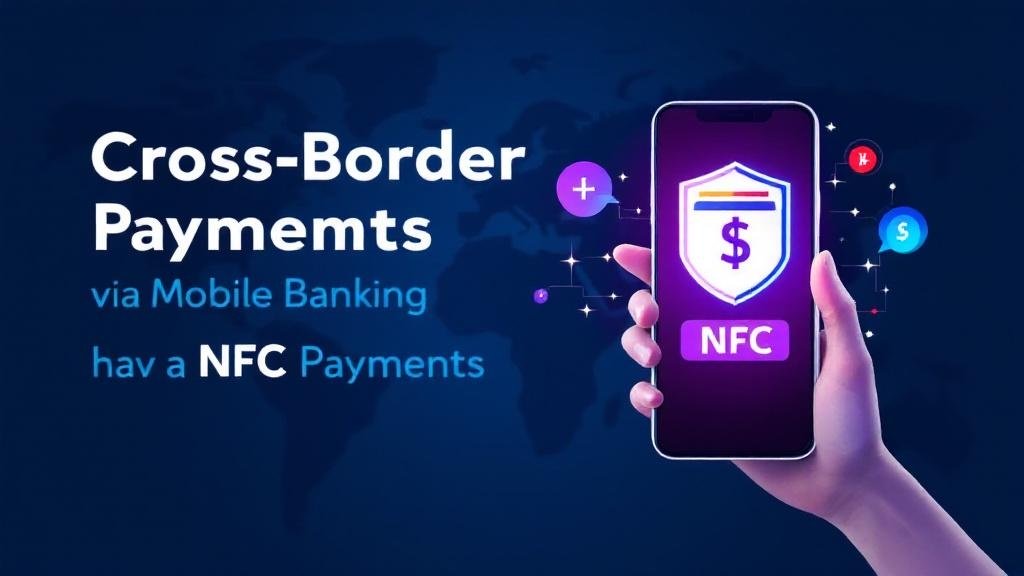The digital world is constantly evolving, and mobile banking has made sending money internationally easier than ever before. Cross-border payments, once a complex and slow process, can now be completed in a matter of seconds using Near Field Communication (NFC) technology. With the rise of NFC-enabled devices and digital wallets, sending money across borders via mobile banking is not only fast but secure and convenient.
In this blog post, we’ll dive into how NFC payments in mobile banking are revolutionizing cross-border transactions, exploring the key NFC payment systems, benefits, and how users can take advantage of NFC mobile banking for fast and secure international payments.
What Is NFC Technology in Mobile Banking?
Near Field Communication (NFC) is a short-range wireless communication technology that allows devices to communicate with each other when placed within a few centimeters of each other. In the context of mobile banking, NFC enables smartphones, tablets, or other NFC-enabled devices to make secure, contactless payments.
By integrating NFC into mobile banking apps, banks and financial institutions allow users to perform quick tap payments for everything from in-store purchases to cross-border money transfers.
Key Features of NFC Payments in Mobile Banking:
Contactless Technology: NFC payments allow for contactless transactions, meaning you don’t need to swipe a card or enter PIN codes. Just a simple tap on the phone is enough.
Fast Transactions: NFC enables faster transactions compared to traditional methods, making it ideal for real-time cross-border payments.
Security: NFC transactions in banking come with built-in security features like tokenization, encryption, and biometric authentication to protect your money.
Convenience: NFC mobile banking enables payments on the go, without needing to carry cash or cards, making it a hassle-free way to send money internationally.
How NFC Payments Are Changing Cross-Border Payments
In the past, sending money abroad was often a lengthy and expensive process. Traditional methods like wire transfers, bank drafts, and money orders could take several days to process, with high fees attached. However, with NFC payment systems integrated into mobile banking, sending money across borders is now easier, cheaper, and faster than ever.
Here are some key benefits of using NFC payments for cross-border transactions:
1. Speed and Efficiency
NFC payments make cross-border transactions almost instantaneous. Whether you’re sending money to a relative overseas or paying for international services, the process is quicker than traditional banking methods.
2. Lower Transaction Costs
Cross-border transactions traditionally come with hefty fees—ranging from service charges to exchange rate markups. NFC mobile payments, however, have significantly reduced these costs, especially when used with mobile wallets or digital banking apps. Some platforms even offer zero-fee international transfers.
3. Security
When it comes to financial transactions, security is paramount. NFC transactions in banking use advanced encryption methods and tokenization to ensure that your payment data remains safe. Additionally, with NFC payment apps, you can take advantage of multi-factor authentication and biometric verification for extra layers of security.
4. Global Accessibility
NFC payments are not limited by geographic boundaries. All you need is an NFC-enabled device and a reliable internet connection, and you can send money across the world in just a few taps.
5. Seamless User Experience
Mobile wallets and NFC-enabled devices provide a seamless experience for sending money abroad. Unlike traditional banking systems that require manual account details, NFC payments allow for a streamlined and user-friendly interface that makes international transfers easier.
The Role of NFC Payment Systems in Mobile Banking
As the demand for mobile payment solutions grows, NFC payment systems have become an essential component of digital wallets in banking. These systems allow users to perform secure, quick tap payments for both local and international transactions.
Let’s explore some of the major NFC payment methods and how they’re contributing to mobile banking:
1. NFC Payment Apps
NFC payment apps like Google Pay, Apple Pay, and Samsung Pay have become widespread in mobile banking. These apps enable users to store payment information securely and perform contactless payments worldwide. When sending money internationally, these apps facilitate real-time transfers with just a tap of your NFC-enabled phone.
2. Mobile Wallet NFC Payments
Mobile wallets, such as PayPal and Venmo, also support NFC payments. By linking your bank account, credit card, or debit card to your mobile wallet, you can send money abroad instantly. NFC-enabled mobile wallets make transactions more efficient by eliminating the need for traditional credit card swipes or manual bank transfers.
3. Secure NFC Transactions
When using NFC payments for cross-border transfers, security is a priority. Most NFC payment systems utilize tokenization, where your payment information is replaced with a unique token. This ensures that sensitive data is never shared directly with merchants or third parties, making NFC transactions highly secure.
4. Payment Authentication Methods
NFC mobile banking comes with various payment authentication methods, including fingerprint scanning, facial recognition, or PIN entry, making it more secure than traditional payment methods.
5. Quick Tap Payments
One of the standout features of NFC payments is the ability to make quick tap payments. By simply tapping your phone near an NFC-enabled terminal, you can instantly complete your transaction—whether it’s a purchase or sending money abroad.
How NFC Mobile Banking Works for International Transfers
So, how exactly does NFC mobile banking work for cross-border payments? Let’s walk through the typical process of sending money internationally via NFC-enabled mobile banking apps:
Setup Your Mobile Wallet: Download a trusted NFC payment app, such as Google Pay or Apple Pay, and link your bank account or credit card details.
Select the Recipient: Enter the recipient’s information, including their phone number or email address.
Initiate the Transaction: Choose the amount you wish to send and confirm the transaction using your phone’s biometric authentication method (e.g., fingerprint or face recognition).
Payment Processing: The NFC payment app will securely transmit the payment data to the recipient’s mobile wallet, processing the transaction almost instantly.
Confirmation: Both you and the recipient will receive transaction confirmations, with funds instantly transferred across borders.
Real-Life Example:
Consider a scenario where you’re sending money to a friend in the US. With NFC-enabled mobile banking, you simply open your mobile wallet, select the recipient, enter the amount, and confirm the payment with your fingerprint. Within seconds, your friend receives the funds, ready to use or withdraw, without needing to wait days for a wire transfer.
The Future of NFC Payments in Mobile Banking
The mobile payment industry is growing rapidly, and NFC payments are leading the way. As more users adopt smartphones with NFC capabilities and digital wallets become more integrated into banking services, the future of NFC payments looks even brighter.
We can expect continued innovations in NFC payment systems, making them even more secure, convenient, and efficient. Features like AI-powered fraud detection, enhanced mobile payment apps, and improved contactless technology in banking will further revolutionize how we make cross-border payments.
Key Trends to Watch:
Mobile Payment Convenience: With growing smartphone penetration and the rise of digital wallets, NFC payments will continue to offer unparalleled convenience for both domestic and international transactions.
Mobile Banking Fraud Prevention: Advanced security measures, such as biometric authentication and AI-powered fraud prevention systems, will enhance the trustworthiness of NFC payment methods.
Global Adoption of NFC Payment Systems: NFC payment methods will become more widely accepted globally, allowing users to send money to more countries with ease.
FAQs: Understanding NFC Payments in Mobile Banking
1. What is NFC in mobile banking?
NFC (Near Field Communication) in mobile banking allows users to make secure, contactless payments using NFC-enabled devices like smartphones, tablets, or smartwatches.
2. How do NFC payments work for cross-border transactions?
NFC payments enable you to send money internationally by simply tapping your NFC-enabled device. The payment is securely processed and transferred to the recipient in real-time.
3. Is NFC secure for mobile banking?
Yes, NFC payments are highly secure, using encryption, tokenization, and biometric authentication to protect your payment data from fraud.
4. Can I use NFC payments in any country?
Yes, NFC payments can be used in most countries worldwide, as long as both the sender and recipient have access to NFC-enabled devices and mobile wallets.
5. What are the benefits of NFC payments in mobile banking?
NFC payments offer several benefits, including fast transactions, lower fees, enhanced security, and a seamless user experience for sending money internationally.
6. Are NFC payments accepted everywhere?
While NFC payments are becoming widely accepted, they may not be available in all locations. Check with your mobile wallet or banking app to confirm the availability of NFC payment services in your region.
7. What are the future trends in NFC mobile banking?
In the future, NFC mobile banking will likely include advanced fraud prevention, AI-powered features, and increased global adoption of NFC payment systems, making cross-border transactions faster and more secure.








Comments (0)